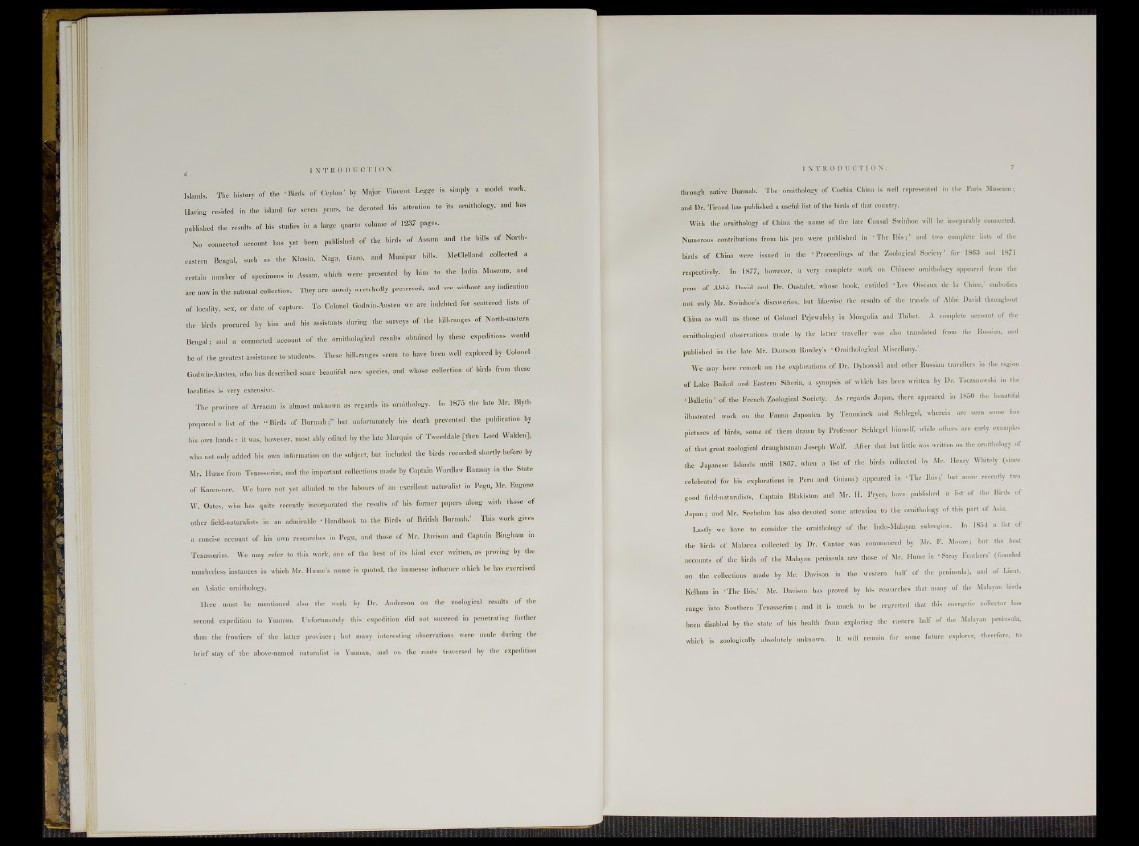
Wands. The history of the 'Birds of Ceyion' by Major Vincent Legge is shnply a model work.
Having resided in the island for seven years, he devoted his attention to its ornithology, and has
published the results of his studies in a large quarto volume of 1237 pages.
No connected account has yet been published of the birds of Assam and the hills of Northeastern
Bengal, such as the Khasia, Naga, Garo, and Manipur hills. McClelland eolleeted a
certain number of specimens in Assam, which were presented by him to the India Museum, and
are now in the national collection. They are mostly wretchedly preserved, and are without any indication
of locality, sex, or date of capture. To Colonel Godwin-Austen we are indebted for scattered lists of
the birds procured by him and his assistants during the surveys of the bill-ranges of North-eastern
Bengal; and a connected account of the ornithological results obtained by these expeditions would
be of the greatest assistance to students. These hill-ranges seem to have been well explored by Colonel
Godwin-Austen, who has described some beautiful new species, and whose collection of birds from these
localities is very extensive.
The province of Arracan is almost unknown as regards its ornithology. In 1875 the late Mr. Blyth
prepared a list of the “ Birds of Bnrmahbut unfortunately bis death prevented the publication by
bis own hands : it was, however, most ably edited by the late Marquis of Tweeddale [then Lord Walden],
who not only added his own information on the subject, but included the birds recorded shortly before by
Mr. Hume from Tenasserim, and the important collections made by Captain Wardlaw Ramsay in the State
of Karen-nee. We have not yet alluded to the labours of an excellent naturalist in Pegu, Mr. Eugene
W. Oates, who has quite recently incorporated the results of his former papers along with those of
other field-naturalists in an admirable • Handbook to the Birds of British Burmah.’ This work gives
a concise account of his own researches in Pegu, and those of Mr. Davison and Captain Bingham in
Tenasserim. We may refer to this work, one of the best of its kind ever written, as proving by the
numberless instances in which Mr. Hume’s name is quoted, the immense influence which he has exercised
on Asiatic ornithology.
Here must he mentioned also the work by Dr. Anderson on the zoological results of the
second expedition to Yunnan. Uufortunately this expedition did not succeed in penetrating further
than the froutiers of the latter province; hut many interesting observations were made during the
brief stay of the above-named naturalist in Yunnan, and on the route traversed by the expedition
through native Burmah. The ornithology of Cochin China is well represented in the Paris Museum ;
and Dr. Tiraud has published a useful list of the birds of that country.
With the ornithology of China the name of the late Consul Swinhoc will be iuseparably connected.
Numerous contributions from his pen were published in ‘The Ibis;’ and two complete lists of the
birds of China were issued in the ‘ Proceedings of the Zoological Society’ for 1863 and 1871
respectively. In 1877, however, a very complete work on Chinese ornithology appeared from the
pens of Abbé David and Dr. Oustalet, whose book, entitled • Les Oiseaux de la Chine,’ embodies
not only Mr. Swinhoe’s discoveries, but likewise the results of the travels of Abbé David throughout
China as well as those of Colonel Prjewalsky in Mongolia and Thibet. A complete account of the
ornithological observations made by the lutter traveller was also translated from the Russian, and
published in the late Mr. Dawson Rowley’s ‘ Ornithological Miscellany.’
We may here remark on the explorations of Dr. Dybowski and other Russian travellers in the region
of Lake Baikal and Eastern Siberia, a synopsis of which has been written by Dr. I aczanowski in the
‘Bulletin’ of the French Zoological Society. As regards Japan, there appeared in 1850 the beautiful
illustrated work on the Fauna Japonica by Temminck and Schlegel, wherein are seen some line
pictures of birds, some of them drawn by Professor Schlegel himself, while others are early examples
of that great zoological draughtsman Joseph Wolf. After that but little was written on the ornithology of
the Japanese Islands until 1867, when a list of the birds collected by Mr. Henry Whitely (since
celebrated for his explorations in Peru and Guiana) appeared in ■ The Ibis hut more recently two
good field-naturalists, Captain Blakistou and Mr. H. Pryer, have published a list of the Birds of
Japan ; and Mr. Seebohm has also devoted some attention to the ornithology of this part of Asia.
Lastly we have to consider the ornithology of the Indo-Malayan subregion. In 1854 a list of
the birds of Malacca collected by Dr. Cantor was commenced by Mr. F. Moore; but the best
accounts of the birds of the Malayan peninsula are those of Mr. Hume in ' Stray Feathers' (founded
on the collections made by Mr. Davison in the western half of the peninsula), and of Lieut.
Kelham in ‘The Ibis.’ Mr. Davison has proved by his researches that many of the Malayan birds
range into Southern Tenasserim; and it is much to be regretted that this energetic collector has
been disabled by the state of his health from exploring the eastern half of the Malayan peninsula,
which is zoologically absolutely unknown. It will remain for some future explorer, therefore, to